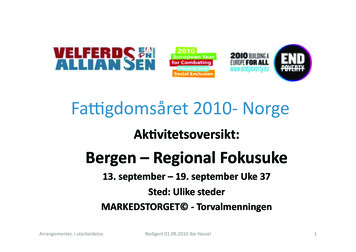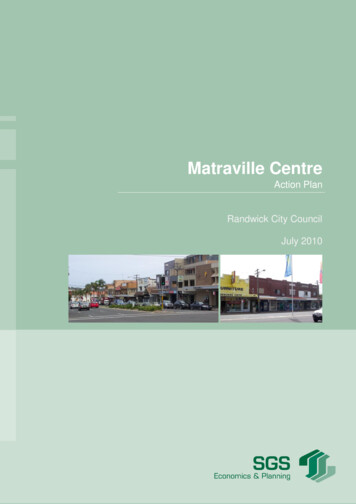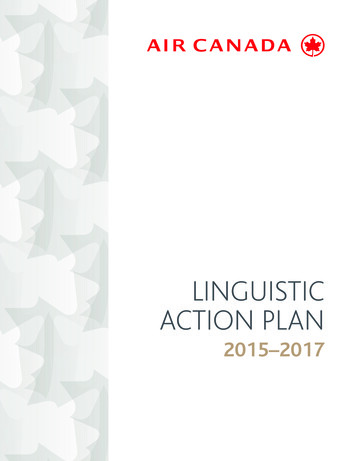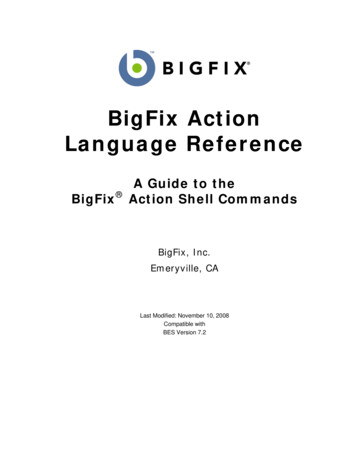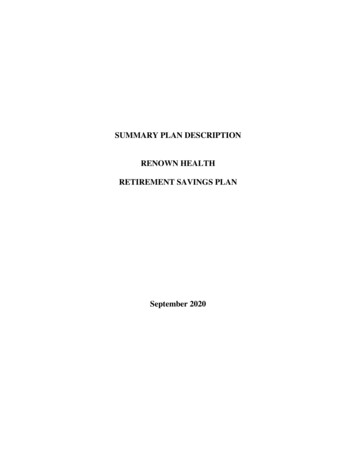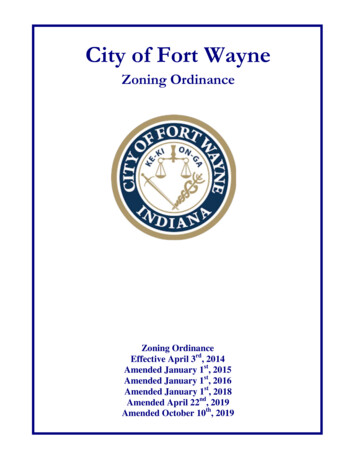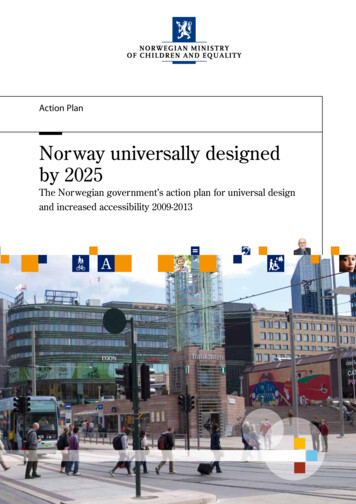
Transcription
Action PlanNorway universally designedby 2025The Norwegian government’s action plan for universal designand increased accessibility 2009-2013
Action PlanNorway universally designedby 2025The Norwegian government’s action plan for universal designand increased accessibility 2009-20131
ForewordThe Ministry of Children and Equality is responsible for promoting equality and preventingdiscrimination on the basis of gender, age, sexualorientation, skin colour, ethnicity, religion ordisability. Through this action plan for universaldesign and increased accessibility, the government is bringing both the equality policy andsustainability policy an important step further.The government’s vision is for Norway to beuniversally designed by 2025. This is ambitiousbut possible. The action plan shows how the government will lay the foundation for achieving thisambition through various goals and measuresthat are subject to deadlines.Oslo, 14. mai 2009For people with a disability, accessibility is animportant factor in their ability to take part insociety. A lack of accessibility has a discriminatoryeffect.The Government’s work is based on universaldesign. Universal design is an expression of avalue put on equality by society. Basing socialdevelopments on universal design providesbetter and more equal surroundings for peoplewith a disability. It also results in social qualitiesthat are positive for the entire population and forNorway as a society.Anniken HuitfeldtMagnhild Meltveit KleppaMinister of Children and EqualityMinister of Local Government andUniversal design also contributes to social andeconomic sustainability and is therefore part ofthe national sustainability strategy.This is a plan that affects most areas of society. Allthe ministries are involved in implementing theplan. A wide range of tools is to be used to reachall levels of the public sector and help to developthe private sector. This work will be coordinatedwith the National Transport Plan 2010-2019.Regional DevelopmentLiv Signe NavarseteErik SolheimMinister of Transport andMinister of the Environment andCommunicationsInternational DevelopmentHeidi Grande RøysMinister of Government Administration and Reform2
ContentsForeword . . . . . . . . . . . . . . . . . . . . . . . . . . . . . . . . . . . . . . . . . . . . . . . . . . . . . . . . . . . . . . 2Contents . . . . . . . . . . . . . . . . . . . . . . . . . . . . . . . . . . . . . . . . . . . . . . . . . . . . . . . . . . . . . . 31Introduction . . . . . . . . . . . . . . . . . . . . . . . . . . . . . . . . . . . . . . . . . . . . . . . . . . . . . . . . . 42National goals and strategies for universal design and increased accessibility . . . . . . . . . . . . . . . 72.1 The plan’s main goals . . . . . . . . . . . . . . . . . . . . . . . . . . . . . . . . . . . . . . . . . . . . . . . . . . 72.2 Implementation of universal design that is subject to deadlines prior to 2025 . . . . . . . . . . . . . 72.3 Strategy . . . . . . . . . . . . . . . . . . . . . . . . . . . . . . . . . . . . . . . . . . . . . . . . . . . . . . . . . . 82.3.1 An integrated and cross-sectoral effort . . . . . . . . . . . . . . . . . . . . . . . . . . . . . . . . . . . 82.3.2 Use of legal instruments . . . . . . . . . . . . . . . . . . . . . . . . . . . . . . . . . . . . . . . . . . . . . 92.3.3 Use of non-legal instruments . . . . . . . . . . . . . . . . . . . . . . . . . . . . . . . . . . . . . . . . . 102.3.4 Further details concerning the use of economic instruments . . . . . . . . . . . . . . . . . . . . 102.3.5 Focus on four prioritised areas of commitment . . . . . . . . . . . . . . . . . . . . . . . . . . . . . 113Measures in the four prioritised areas . . . . . . . . . . . . . . . . . . . . . . . . . . . . . . . . . . . . . . . . 133.1 Building and construction . . . . . . . . . . . . . . . . . . . . . . . . . . . . . . . . . . . . . . . . . . . . . 133.1.1 Goals . . . . . . . . . . . . . . . . . . . . . . . . . . . . . . . . . . . . . . . . . . . . . . . . . . . . . . . . 133.1.2 Strategies and completed and on-going measures . . . . . . . . . . . . . . . . . . . . . . . . . . . 133.1.3 Measures . . . . . . . . . . . . . . . . . . . . . . . . . . . . . . . . . . . . . . . . . . . . . . . . . . . . . 153.2 Planning and outdoor areas . . . . . . . . . . . . . . . . . . . . . . . . . . . . . . . . . . . . . . . . . . . . 183.2.1 Goals . . . . . . . . . . . . . . . . . . . . . . . . . . . . . . . . . . . . . . . . . . . . . . . . . . . . . . . . 183.2.2 Strategies and completed and ongoing measures . . . . . . . . . . . . . . . . . . . . . . . . . . . . 183.2.3 Measures . . . . . . . . . . . . . . . . . . . . . . . . . . . . . . . . . . . . . . . . . . . . . . . . . . . . . 193.3 Transport . . . . . . . . . . . . . . . . . . . . . . . . . . . . . . . . . . . . . . . . . . . . . . . . . . . . . . . . 203.3.1 Goals . . . . . . . . . . . . . . . . . . . . . . . . . . . . . . . . . . . . . . . . . . . . . . . . . . . . . . . . 203.3.2 Strategies and implemented and on-going measures . . . . . . . . . . . . . . . . . . . . . . . . . 203.3.3 Measures . . . . . . . . . . . . . . . . . . . . . . . . . . . . . . . . . . . . . . . . . . . . . . . . . . . . . 233.4 ICT . . . . . . . . . . . . . . . . . . . . . . . . . . . . . . . . . . . . . . . . . . . . . . . . . . . . . . . . . . . . 243.4.1 Main goal . . . . . . . . . . . . . . . . . . . . . . . . . . . . . . . . . . . . . . . . . . . . . . . . . . . . . 243.4.2 Strategies and completed and on-going measures . . . . . . . . . . . . . . . . . . . . . . . . . . . 243.4.3 Measures . . . . . . . . . . . . . . . . . . . . . . . . . . . . . . . . . . . . . . . . . . . . . . . . . . . . . 253.5 Sector-overarching measures . . . . . . . . . . . . . . . . . . . . . . . . . . . . . . . . . . . . . . . . . . . 263.5.1 Local authority efforts . . . . . . . . . . . . . . . . . . . . . . . . . . . . . . . . . . . . . . . . . . . . . 263.5.2 Development of indicators and standards . . . . . . . . . . . . . . . . . . . . . . . . . . . . . . . . 273.5.3 The communication policy . . . . . . . . . . . . . . . . . . . . . . . . . . . . . . . . . . . . . . . . . . 283.5.4 Children and young people . . . . . . . . . . . . . . . . . . . . . . . . . . . . . . . . . . . . . . . . . . 293.5.5 Research and development . . . . . . . . . . . . . . . . . . . . . . . . . . . . . . . . . . . . . . . . . . 294Implementation of the action plan . . . . . . . . . . . . . . . . . . . . . . . . . . . . . . . . . . . . . . . . . . 313
1 IntroductionThe goal of increased accessibility in society hashigh priority. The Soria Moria Declaration statesthat the parties in power will prepare an actionplan concerning the accessibility of transport,buildings, information and other important areasof society. The Declaration also states that abinding timetable for accessibility also has to beensured and that the principle of universal designis to form the basis for the government’s work.The government wants to get away from a wayof thinking in which the individual is defined asthe problem and in which special measures forDuring the past few years, several Acts andregulations have been amended in order toensure universal design and increased accessibility. These include: The Planning and Building Act The Universities and University CollegesAct The Vocational Training College EducationAct The County College Act The Primary and Secondary SchoolsEducation Act The Public Procurement Act Education-sector legislation Regulations concerning a framework planfor kindergartens’ contents and tasks Regulations concerning the universaldesign of the transport sector. Regulations concerning impactassessments Regulations concerning basic loans fromthe Norwegian Housing Bank4people with disabilities are the main solution.The universal design of the physical environmentmeans an equal form of accessibility, so that themain solution can be used by as many peopleas possible. This applies not only to people withdisabilities but also, for example, to familieswith children in pushchairs and to the elderly.The government will make systematic efforts topromote knowledge and stipulate a requirementof universal design in the development of thehuman-created environment.The UN Convention on the Rights of Peoplewith disabilities was adopted by the UN GeneralAssembly on 13 December 2006. The Convention’s objective is to ensure that people withdisabilities have a full and equal right to realisetheir human rights.The Convention stipulates that the countries areobliged to implement the necessary measures toensure that people with disabilities have access tothe physical environment, transport, information,communication and other areas and servicesthat are open or offered to the general public.The countries must also make efforts to promoteuniversal design. Norway signed the Convention on30 March 2007. The government is now preparinga parliamentary bill concerning the ratification ofthe Convention. In May 2009, 51 countries, sevenof which were European, had ratified the Convention. The UN human rights conventions form awide-ranging foundation for ensuring the rights ofall people with disabilities, irrespective of their age,gender, sexual orientation or ethnic background.In January 2009, a new, aggressive Act relatingto a prohibition against discrimination on thegrounds of disability (the Anti-Discriminationand Accessibility Act) came into force. The new
Act’s objectives are to strengthen the legalprotection against discrimination on the groundsof disability and to prevent discrimination due,among other things, to a lack of accessibility.The Act stipulates a duty to universally designundertakings that offer goods or services to thegeneral public. Public and private undertakingsthat offer goods or services to the general publicalso have a duty to make active efforts to ensureuniversal design. In addition, employers, bothpublic and private, must make active efforts topromote equality and ensure equal opportunitiesand rights, regardless of functional impairment.The government has appointed a publiccommission to prepare a proposal regardingcompiled, more integrated and strengthenedanti-discrimination legislation in Norway (theAnti-Discrimination Legislation Commission).The Commission is to prepare and submit aproposal regarding a compiled Act to combatdiscrimination and consider how rules regardingaccessibility and adaptation for people withdisabilities can be safeguarded in the Act. TheAnti-Discrimination Legislation Commission is tosubmit its recommendations by 1 July 2009.The government has also initiated an inquiry intopeople with disabilities’ access to goods, servicesand information. This inquiry is to be completedby 1 July 2009. Any proposals to strengthenthe protection against discrimination in theseareas will be included in the follow-up to theAnti-Discrimination Legislation Commission’srecommendations.The Norwegian parliament (Storting) has agreedto the government’s proposed new Planning andBuilding Act. This Act contains new provisionsregarding universal design, including in its statement of legislative purpose. This will strengthenthe implementation of universal design inthe field of local authority planning and newbuilding. The Act also authorises the issuanceof regulations to upgrade categories of existingbuildings, facilities and outdoor areas to universaldesign within further stipulated deadlines.Regulations to further support and stipulate theconsideration of universal design in both theAct’s planning part and building part are in theprocess of being developed.Norway cooperates internationally and follows up a number of recommendations andobligations in the area of universal designand increased accessibility, including:UN The UN Convention on the Rights of Peoplewith disabilities.Council of Europe Resolution: Introduction of universal education in all courses. Resolution: Full participation throughuniversal design. The Council of Europe’s action plan forpeople with disabilities 2006-2015.EU Regulations concerning technical standards for means of transport. The EU Disability Action Plan 2004-2010.Nordic Council of Ministers Cooperation forums with a focus on Designfor everyone/Universal design within thevarious sector areas.Better legislation is one of several instruments forcombating discrimination in the form of a lackof universal design. Administrative measures,improving expertise and economic instrumentsare also important in order to prevent future barriers and remove existing ones.In March 2009, the government introduced aWhite Paper concerning the National TransportPlan 2010-2019. This White Paper underlines thateveryone has an equal right to participate in society. The opportunity to move around in societyeasily, efficiently and safely is crucial for beingable to participate in working life and socialactivities. The government will therefore developand adapt the transport system so that as manypeople as possible are ensured good mobilityand that individual special solutions are avoidedin so far as possible. During the period coveredby the plan, the government will increase theuse of resources considerably in order to pavethe way for the universal design of the transportsystems.5
White Paper (Stortingsmelding) no. 17 (20062007) An Information Society for Everyone placesparticular emphasis on three prerequisites for thegovernment’s work on digital inclusion: digitalaccess, universal design and digital competence.Norway’s strategy for sustainable developmentcreated in 2008 places emphasis on the fact thatuniversal design, in the form of workplaces beingbetter adapted for people with disabilities, willreduce exclusion from working life. It is importantto increase the number of people with disabilitieswho are in work. Increased participation in working life would improve their economic standardof living. The universal design of public transport,buildings and ICT increases their chances ofeducation and work.Accessibility for people with disabilities hasimproved over the past few years. Developmentsvary within the different areas of society. Twosurveys that have assessed the status of the workon universal design and accessibility are: “Fullparticipation for all, Trends 2001-2006”,publishedby the Norwegian Directorate of Health and theNational Centre for Documentation on Disability,and the “Status Report 2007 – Social Developments for People with Disabilities”, publishedby the National Centre for Documentation onDisability.The first report shows that a number of theproposals in Official Norwegian Report (NOU)2001:22 From User to Citizen have either beenimplemented or are being considered. The reportshows that there have been improvements inaccessibility and universal design in the areas ofbuildings, outdoor areas, transport and ICT asregards more attention being paid, better regulations and higher levels of activity.The report also shows that there is some wayleft to go before the overall goal of a society foreveryone has been reached. People with disabilities do not have the same access to importantareas of society as the rest of the population.The greatest challenges are linked to making theexisting surroundings universally designed. Lateranalyses and cost estimates confirm the extent ofthe challenges.6A report entitled “The Status of Accessibility inNorway” was published by the Norwegian StateCouncil on Disability and the National Centrefor Documentation on Disability in 2006. Itconcluded that there is limited knowledge inNorway of accessibility and universal design inimportant areas such as ICT, transport, buildingsand outdoor areas.In the work on this action plan, emphasis hasbeen placed on the provisional results of theexternal evaluation of “The Government’s ActionPlan to ensure Increased Accessibility for Peoplewith Disabilities. A plan to ensure universaldesign in important areas of society” (2005-2008).The evaluation, which is being conducted bythe Norwegian Institute for Urban and RegionalResearch (NIBR), shows that the ministries’ sectorresponsibilities, use of stimulating measuresand development of accessibility and universaldesign norms have been important contributionsto the work of ensuring universal design.Norwegian status reports and internationalcomparisons indicate that Norway has come along way in its legislation in a number of areas,and has implemented universal design relativelywell in its public administration sector. Theseare central qualities for resolving the challengeswhich remain and a good foundation for thefurther work. The government therefore believesit is possible to achieve the vision of a universallydesigned society by 2025.The development of the action plan’s strategyand content has taken place in consultation withrelevant ministries and through several processesthat have requested the views of governmentdepartments, regional administrative authorities,research institutions, the Norwegian State Council on Disability, municipal and county councilcommittees dealing with people with disabilities,interest groups and professional organisations.
2. National goals and strategiesfor universal design and increasedaccessibility2.1. The plan’s main goalsThe action plan is intended to support the implementation of the new Anti-Discrimination andAccessibility Act, new Planning and Building Actand other new legislation dealing with universaldesign. The action plan is also intended to helpmeet Norway’s obligations when Norway ratifiesthe UN Convention on the Rights of People withdisabilities.2.2. Implementation of universal designthat is subject to deadlines prior to 2025The government’s vision that Norway is to be universally designed by 2025 can be achieved usingvarious instruments that are adapted to suit thevarious sectors and tasks. Goals that are subjectto deadlines are used.In some areas, such as in ICT, there are statutoryrequirements regarding when universal designis to have been implemented. In other areas, thedeadline is set when the universal design regulations are implemented.It is an important principle in the government’sstrategy that the main solution for all new procurements, buildings and facilities intended forthe general public is to be universally designed.Plans are also to be based on the principles ofuniversal design. This is assured through suchthings as legislation and guidelines and theefficient follow-up of these.In important areas, such as existing buildingsand outdoor areas, both the extent and cost ofupgrading to universal design are uncertain. Inaddition, the responsibility has been dividedamong a number of different bodies and owners.A survey conducted by the Norwegian Institutefor Urban and Regional Research (NIBR) showsthat it will be very expensive to upgrade existingbuildings, facilities and outdoor areas intendedfor the general public’s use. Due to the majorfinancial cost of upgrading existing buildings,facilities and outdoor areas to universal design, astep-by-step and prioritised approach has beenadopted. The Planning and Building Act includesthe authority to issue regulations regardingupgrades to a standard that is equivalent touniversal design. Over time, requirements as toexisting building categories can be stipulated inseparate regulations. The individual regulationswill determine the deadline for implementing theupgrade.Other surveys and analyses, however, show thatthe additional costs are limited if the upgrade touniversal design takes place through plannedmaintenance and repair work. The governmentplaces emphasis on utilising these opportunities.7
Goals subject to deadlines Based on the Planning and Building Act, regulations may be issued concerning the upgrading ofcategories of buildings, facilities and outdoor areas for the general public by stated deadlines. Existing buildings that are managed by Statsbygg are to be successively upgraded in accordance with Statsbygg’s action plan. The measure is to continue until the universal design requirements have been met in accordance with the vision, ie, by the end of 2025. Relevant underlying state departments are to prepare action plans for universal design by 2011. All local authorities should have adopted a municipal plan containing universal design guidelines by 2015. Universal design should be an integral principle in all regional plans by 2015. All county councils and 25% of the local authorities should actively participate in a nationaldevelopment project aimed at the local authorities and counties by 2014. All local authorities should have actively taken part in the guidance concerning the new Planning and Building Act by 2010. Norwegian State Railways (NSB) has entered into a contract for the delivery of 50 new train setsthat meet the universal design requirements. These train sets will come into operation in 2012. Older railway materials that will be in use after 2010/2011 will be upgraded to as high an accessibility level as possible. On the main road network, almost 100 intersections and around 2,000 out of a total of 6,500 busstops will be upgraded to the desired standard by 2019. For the railways, achieving accessibility at very many stations and the universal design of thebusiest junctions will be given priority. The Public Roads Administration and National RailAdministration are, in dialogue with the user organisations, to prepare specific action plans thatstipulate which of the bus stops and stations are to be prioritised and the measures that are tobe implemented. All new ICT intended for the general public’s use is to be universally designed as from 2011. All existing ICT intended for the general public’s use is to be universally designed as from 2021.Good documentation showing the developmentand effect of various instruments is important toreach the universal design goals that have beendetermined. In order to obtain a better basis forprioritising the efforts from now until 2025, universal design indicators are being developed in keyareas. The data on which the indicators are based isbeing incorporated in so far as possible into existingregisters, such as KOSTRA (the Municipality-StateReporting) and Matrikkelen (the Land Register).In addition, emphasis is placed on obtainingmore detailed statistics and data in order toensure precise planning in the individual sectors.Statsbygg’s registration system and the Norwegian Public Roads Administration’s bus stopregister are examples of this.8Several specific part-goals relating to the visionof universal design by 2025 will be set for moreareas as basic material regarding the statusgradually becomes available.2.3 Strategy2.3.1 An integrated and cross-sectoral effortThe action plan is sector overarching and contains both cross-sectoral and sectoral measures.Cooperation between various administrativestages and levels is important. For this reason,the action plan contains a programme to supportthe local authorities’ work. This programme hasbeen developed in dialogue with the Norwegian
Association of Local and Regional Authorities (KS)and is based, among other things, on experiencegained from the ”Universal Design as a MunicipalStrategy” development project that was carriedout by the Ministry of the Environment togetherwith 17 local authorities from 2005-2008.County councils and county governors are to beinvolved more heavily in the regional and localwork on universal design.Strengthen the sector responsibility principleThe sector responsibility principle is a necessaryand fundamental strategy for achieving the maingoals of the policy concerning people with disabilities. The strategy involves it being the normalbodies in society that are to provide and financethe services offered to people with disabilities inthe same way as to the rest of the population. It isthe same bodies that, as required, are to provideadditional special schemes if the ordinaryschemes are not sufficient.The individual ministry is to review its area ofresponsibility and assess the need for additionaldeadlines and specific measures. Relevant underlying departments are to prepare action plans foruniversal design by 2011. This work is also to belinked to the duty to carry out activities that hasbeen stipulated in the Anti-Discrimination andAccessibility Act.Increased contribution and cooperationIn order for the plan to be implemented efficiently and well, there must be close cooperationbetween the ministries affected.Emphasis will be placed on a close dialoguewith the Norwegian State Council on Disability,interest groups for people with disabilities andprofessional organisations.The Ministry of Children and Equality is responsible for administering the ”Act relating to councilsor other representation schemes for people withdisabilities, etc, in local authorities and countycouncils”. These councils have, among otherthings, tasks in relation to universal design andaccessibility within the local authority and countycouncil’s activities. The government’s action planfor universal design and accessibility includesways of supporting the councils’ work, such asthrough measures to enhance competence.Information that the ministry obtained from thecounty governors in 2008 shows that 87% of thelocal authorities have established councils orsome other form of representation. The ministryhas implemented measures to achieve councilsfor people with disabilities throughout Norway.The Norwegian Association of Local and RegionalAuthorities (KS) will be involved in discussions ofmatters relating to the municipal sector.2.3.2 Use of legal instrumentsThe use of legal means forms an important partof the overall strategy for promoting universaldesign. A new foundation has been laid throughthe new Anti-Discrimination and AccessibilityAct. This Act provides legal protection againstdiscrimination on the grounds of disability in allareas of society. The Act contains a discriminationpart and an accessibility part, in addition to rulesconcerning a duty to be active.The universal design obligation in the Anti-Discrimination and Accessibility Act is a minimumrequirement and has been introduced at thesame time as a legal standard. A legal standardis a concept that has legal consequences butwhose content is determined on the basis ofnorms that may change over time, for example inline with technological developments.The duty to have universal design applies topublic and private undertakings that offer goodsor services to the general public. A breach of thisduty is to be regarded as discrimination unlessthe duty entails a undue burden. When assessingwhether or not a burden is undue, emphasis isto be placed on the adaptation’s effect on thedismantling of disabling barriers, whether theundertaking’s normal function is of a publicnature, the necessary costs of the adaptation, theundertaking’s resources, security considerationsand safety considerations.Equality and universal design have beenstrengthened in several Acts, including the newPlanning and Building Act. A further strengthening in existing sector legislation is continuously9
The government’s action plan for universaldesign and increased accessibility coversmeasures in 16 ministries’ areas of responsibility. Key measures for achieving universaldesign and equality for people with disabilities have been included in and are describedin greater detail in action plans and strategiesfor the individual areas.These include: The National Transport Plan 20102019 (Ministry of Transport andCommunications), The National Sustainability Strategy (Ministry of Finance). Action Plan for Architecture Policy (Ministryof Culture and Church Affairs) Environmental Action Plan for the Housingand Construction Sector 2009-2012 (Ministry of Local Government and RegionalDevelopment) Action Plan for Local Air Quality (Ministry ofthe Environment) Asthma/allergy Strategy (Ministry of Healthand Care Services). New Action Plan for Habilitation andRehabilitation (Ministry of Health and CareServices). The Government’s Consumer Policy –Action Programme 2008-2009 (Ministry ofChildren and Equality). Outdoor Life for People with Disabilities(Directorate for Nature Management) Universal Design of Cultural Monuments(Directorate for Cultural Heritage) Nordic Regional Policy CooperationProgramme 2009-2012 (Nordic Council ofMinisters/ Ministry of the Environment).
The Norwegian government's action plan for universal design and increased accessibility 2009-2013 Published by: Norwegian Ministry of Children and Equality Public institutions may order additional copies from: Norwegian Government Administration Services Distribution Services E-mail: publikasjonsbestilling@dss.dep.no Fax: 47 22 24 27 86
